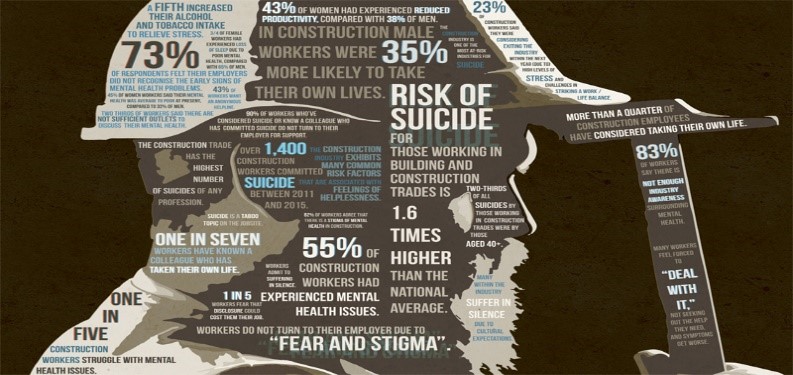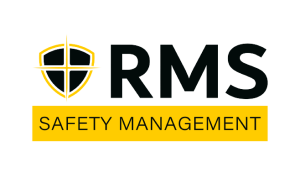Please take a moment to read this paper about Mental Health Awareness in Construction, written by our employee Marc Myers. It is well worth the read!

When you think about the subject of workplace health and safety, does mental health come to mind? If it does, you are ahead of the curve. Most associate workplace health and safety with topics such as fall protection, excavations, lockout tagout, chemical exposures, and other concerns that have stollen the spotlight for decades. While all those risks are important and deserve our attention… it’s time to share the spotlight with mental health.
Why do I say this? Because it is a growing epidemic in the United States that is taking lives. Here are few quick facts (published by the Center for Disease Control) that are mind blowing:
- Of the 12 million adults in the US who seriously think about suicide each year, 3 million will plan their suicide, 1 million will attempt suicide, and 48,000 will succeed.
- The suicide rate for construction workers is 4 times higher than the national average.
- 1 in 5 adults will be diagnosed with a mental health disorder this year.
Do these stats surprise you? The reality is that several of your friends, family and coworkers likely struggle with mental health disorders. Maybe you even struggle with it or will. I believe we are all directly or indirectly affected by it in some way. I know I have been!
I will never forget October 15, 1990. On that day one of my brothers took his own life with a gun. It seemed like everything was going well for him. He had a good job (in the Construction Industry), a beautiful wife and two young kids. His decision that day devastated so many people. Why didn’t he reach out to me? Why didn’t he talk to a friend or someone else? As much as I want to go back and stop my brother from making that mistake, it’s not an option. I cannot change the past, but I can use my voice to raise awareness, encourage others to act, and hopefully change the future.
I personally want to drive this change because I know the pain that’s involved, and I don’t want anyone else to experience it. It’s personal for me. However, mental health disorders also have a negative impact on businesses. When people suffer mentally it typically results in unclear thinking, distraction, and reduced motivation (among other issues). When translated to the workplace, that means more mistakes, an increased risk of injury, less productivity, and more absences.
If someone takes their life, it leaves the company with a labor shortage until the position is filled, which affects production and puts more stress on the remaining workforce. It also takes time and money to recruit and hire new employees. If an unexperienced employee is hired, their level of productivity will start off low and their risk of injury will be higher until they become familiar with the work. In addition, coworkers who were close with the individual who took their life will grieve, which will result in the issues stated in the last paragraph. Simply stated… mental health disorders cost companies a LOT of money. In fact, the Center for Disease Control estimates that mental health disorders cost each company $60,000 a year on average!
So, what should companies do about this? Here is some advice that I encourage each company to seriously consider:
- Acknowledge the fact that this is a serious problem that demands your attention. Without business owners “owning” this concern, change will not occur.
- Be careful to hire/promote managers and supervisors that are skilled at managing people in a professional and positive manner. Companies often promote their most productive employees into leadership positions, but those people may not always have the skillset, desire or patience to teach, communicate, listen, and guide people effectively. Reporting to difficult supervisors is one of the biggest stressors employees face.
- Evaluate work practices to make sure an adequate number of employees are hired. Another big stressor happens when employees are asked to perform more work than they can or should be responsible for.
- Provide a clean and safe work environment with the tools that are necessary to perform each task correctly. Working in unkept unsafe environments and trying to perform work without the tools needed generates unnecessary stress.
- Create an open channel for employees to communicate concerns and take their concerns seriously. When an employee expresses a concern and nothing is said or done, it can create more harm than good.
- Make sure you have programs that help employees cope with stress at work and home. This includes offering health insurance that covers mental health disorders and offering “Employee Assistance Programs”. Statistics show that only 43% of US employers offer health insurance that covers mental health disorders, and only 29% have an Employee Assistance Program.
- Have frequent open discussions with employees about the importance of mental health, promote your Employee Assistance Program, and encourage everyone to get help if needed. When having these discussions, do your best to break the stigma associated with mental health disorders by letting them know “It’s okay to not be okay”.
For those who already “own” mental health as a serious concern, thank you! I hope this article confirms that you are on the right track. For those who don’t… it’s time to act. Your actions can save your company lost profit, create a better work environment, and most importantly – save lives. Together, we can make a difference.

